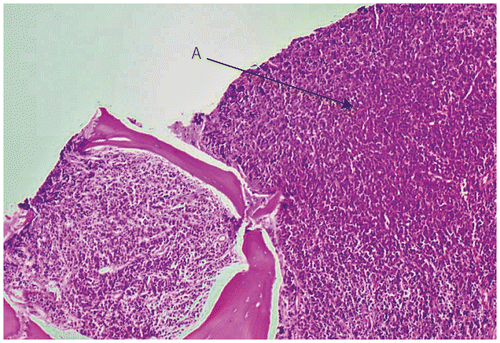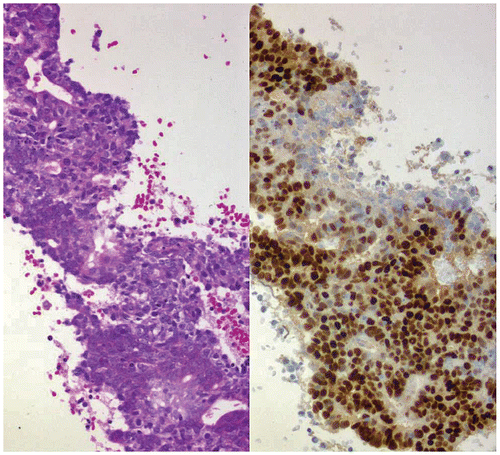Abstract
A case is presented of a 67-year-old woman referred to the authors’ institution with endometrioid endometrial cancer with a leucoerythroblastic blood film and marked thrombocytopenia. On further evaluation, it was confirmed that she had grade 3 endometrial cancer with bone marrow involvement (FIGO stage IVB). This is a rare complication of endometrial cancer and her marked thrombocytopenia severely limited her treatment options.
Introduction
In South Africa, the age-standardised incidence rate (ASIR) of endometrial cancer is 6.9 per 100 000, which is higher than the African average of 3.5 per 100 000 women.Citation1 In the Western world, endometrial cancer is now the commonest gynaecological malignancy, with an ASIR of 13.6 per 100 000 women in Europe.Citation1 The survival rate is high, since 70% of women present with disease confined to the uterus because post-menopausal bleeding, the commonest symptom, manifests early.Citation2,3 However, mortality from endometrial cancer is rising faster than the incidence, due to an increased rate of advanced disease, non-endometrioid histological types and older age at diagnosis along with the increase in life expectancy.Citation4 Metastatic endometrial cancer is generally managed by palliative therapy including hormonal, chemotherapy and radiotherapy. Palliative hysterectomy may play a role in a select group of patients. Endometrial cancer commonly metastasises to retroperitoneal lymph nodes, lungs, liver, brain and bones. We present a rare case of a woman with grade 3 endometrioid endometrial cancer metastatic to the bone marrow causing a leucoerythroblastic blood film and marked thrombocytopenia. We also review the literature and discuss the limited treatment options available in this clinical scenario.
Case report
Initial presentation
A 67-year-old, G4P4, post-menopausal woman presented to a secondary-level hospital in Cape Town with unintentional loss of weight of 40 kg (from 100 to 60 kg) over a period of 12 months. She also reported progressively worsening post-menopausal bleeding, melaena stools and occasional lower abdominal pain for the preceding five months. At her initial presentation she had normochromic anaemia of 8.8 g/dl (reference range 12–15 g/dl) and platelet count of 161 x 109/l (reference range 180–400 x 109/l). An outpatient endometrial biopsy was taken at that initial visit using a Pipelle®. She was lost to follow-up and re-presented five months later at the same hospital when her haemoglobin had dropped to 5.3 g/dl (the platelet count was not repeated). She was transfused with three units of packed red blood cells before referral to our tertiary-level institution. She gave a history of becoming menopausal at 50 years of age and had no history of hormone replacement therapy use. She was on hydrochlorothiazide for hypertension and was also known to have osteoarthritis for which she used an aspirin-containing over-the-counter (OTC) drug. She had no family history suggestive of hereditary gynaecological malignancy.
On physical examination she was apyrexial, her blood pressure was elevated at 163/95 and her pulse was normal at 79 beats per minute. She had conjunctival pallor, with Heberden’s nodes on the distal interphalangeal joints of her fingers, but had no significant lymphadenopathy. Her thyroid, breast and respiratory examinations were normal. On rectal examination, there was no rectal mass palpated but there was melaena stool on the glove. Her gynaecological examination revealed an atrophic vulva, vagina and cervix with grade 2 uterine prolapse. The endometrial biopsy performed at the secondary-level hospital had scanty curettings. Our working diagnoses on admission to GSH were endometrial carcinoma and upper gastrointestinal tract bleeding likely due to chronic aspirin use.
Subsequent investigations and management
The full blood count and smear revealed a normocytic normochromic anaemia with a haemoglobin of 8.0 g/dl, a marked thrombocytopenia of 39 x 109/l and a normal white cell count of 11.4 x 109/l. The smear confirmed the thrombocytopenia and showed nucleated red blood cells and leftshifted granulocytes in keeping with a leucoerythroblastic blood picture. Her international normalised ratio (INR) was normal at 1.18. Her iron studies were normal; vitamin B12 was mildly reduced at 106 pm/l (reference range 145–569 pmol/l). The creatinine was 98 μm/l and her gamma-glutamyl transferase was 47 U/l. There was no evidence of pulmonary metastases on her chest X-ray, and abdominal ultrasound scan showed an 11.6 mm hypoechoic lesion on the splenic hilum, reported as likely to be a splenunculus or lymph node. Her mammogram was normal. Gastroscopy showed multiple ulcerations in the antrum and pylorus of her stomach, for which she received empirical Helicobacter pylori eradication therapy. Clinical Haematology was consulted regarding the persistent thrombocytopenia and normocytic anaemia, which was not consistent with upper gastrointestinal bleeding. Bilateral posterior superior iliac crest bone marrow biopsies were subsequently performed.
The bone marrow trephine showed heavy infiltration by a non-haematopoietic malignancy staining positive for oestrogen receptors on immunohistochemistry (see Figure ). On pathological review, the Pipelle® endometrial biopsy had scanty superficial tissue only, with areas showing atypical hyperplasia and grade 1 endometrioid endometrial cancer (see Figure ). The bone marrow findings were compatible with involvement with a grade 3 endometrioid endometrial cancer. The conclusion was that the Pipelle® had scanty tumour that was not fully representative of the tumour, hence the discrepancy of tumour grade with the bone marrow results.
Tumour board discussion
At our institution all gynaecological oncology cases are discussed with a multidisciplinary team, comprising gynaecological and radiation/medical oncologists. Patients are involved in decision-making about their care in this clinic. Based on the bone marrow metastases, she was staged as Federation of Gynecology and Obstetrics (FIGO) stage IVB, grade 3 endometrioid endometrial cancer. Treatment for these patients is individualised, and usually includes a combination of palliative hormonal, chemotherapy and radiotherapy. Rarely, palliative surgery such as hysterectomy is used to control intractable uterine bleeding. This case was the first in our unit of proven endometrial cancer manifesting as persistent anaemia and marked thrombocytopenia due to bone marrow infiltration. There is no evidence from the literature on how patients with this rare complication are best managed. Grade 3 endometrioid endometrial cancer is known to have a low response to hormonal therapy. Carboplatin and taxanes are the chemotherapeutic agents of choice in advanced or metastatic endometrial cancer; however, they are myelotoxic, precluding their use in this patient with minimal residual normal haemopoeisis. Palliative pelvic radiation can be used in women with metastatic endometrial cancer to control uterine bleeding. However, haematological adverse effects are known to occur more commonly in women with endometrial cancer who receive pelvic radiotherapy.Citation5 Since her vaginal bleeding was well controlled with tranexamic acid, an anti-fibrinolytic drug, it was decided to withhold radiotherapy, and palliative surgery under platelet cover was not indicated. The lack of therapeutic options was discussed with the patient and her family. We offered her supportive care and involved social workers, hospice and palliative care teams as part of the multidisciplinary team looking after her. One week after discharge she was readmitted to the referring secondary-level hospital with gastrointestinal and genital tract bleeding, haemoptysis and renal failure. She received blood products and was discharged home. The bleeding recurred a day after discharge, and she collapsed and died at home, about five weeks after the initial referral to GSH.
Discussion
In contrast to early-stage endometrial cancer where the five-year survival rates are more than 95%, endometrial cancer patients with distant metastases have dismal survival rates of less than 20%.Citation6 However, metastasis to the bone marrow from solid tumours is very rare. In a study from Turkey, 3 842 bone marrow biopsies were analysed and only 1.9% had evidence of bone marrow infiltration by solid tumours. Only 1.4% of the patients with bone marrow metastases from solid tumours had endometrial cancer. Breast cancer was the commonest primary with bone marrow involvement in 28.8% of patients with solid tumours.Citation7 Anaemia and thrombocytopenia were the commonest indicators of bone marrow involvement.Citation7 Median survival after diagnosis of bone marrow infiltration was five months. In patients with bone marrow involvement, thrombocytopenia was a poor prognostic factor. In patients with thrombocytopenia median survival was only one month compared with 13 months in those with normal platelet counts.Citation7 In a retrospective study of 124 cases of solid tumours in northern India, 25% had proven metastases to the bone marrow. The highest number, 36% of bone marrow infiltration, was seen in prostate carcinoma followed by gastric carcinoma and melanoma (25%). The least number of cases (14.2%) of bone marrow metastases were observed in endometrial carcinoma.Citation8
Hormonal treatment is more effective in women with grade 1 or 2 endometrial cancer, especially those who are oestrogen (ER) and progesterone (PR) receptor positive.Citation9,10 The response rate for progestogens in grade 3 endometrial cancers is < 10%, so their role in our patient was limited.Citation9,10 Other hormonal drugs such as tamoxifen and aromatase inhibitors are associated with a similar response rate of about 10%.Citation11–13 Carboplatin and paclitaxel have been shown to be non-inferior to paclitaxel, cisplatin and doxorubicinCitation14 but chemotherapy is known to cause myelosuppression, which makes it an unsuitable option in women with bone marrow metastases and cytopenias. In our patient with grade 3 endometrial cancer with bone marrow infiltration and platelet counts persistently < 50 × 109/l, we had no suitable evidence-based treatment options available. We opted for supportive care and she died five weeks after diagnosis.
Conclusion
Although bone marrow infiltration by endometrial cancer is rare, it should be suspected in patients with persistent anaemia out of keeping with their vaginal bleeding, especially if accompanied by a leucoerythroblastic blood picture and unexplained thrombocytopenia or leucopenia. The prognosis is poor in these patients and there is little in the way of evidence-based data to guide their management.
Disclosure statement
No potential conflict of interest was reported by the authors.
References
- Ferlay J, Soerjomataram I, Ervik M, et al. GLOBOCAN 2012 v1.0, Cancer incidence and mortality worldwide: IARC cancer base No. 11 [Internet]. Lyon: International Agency for Research on Cancer; 2013 [cited 9 2017 Sep]. Available from: http://globocan.iarc.fr
- Siegel R, Ma J, Zou Z, et al. Cancer statistics, 2014. CA Cancer J Clin. 2014;64(1):9–29.10.3322/caac.21208
- Lajer H, Elnegaard S, Christensen RD, et al. Survival after stage IA endometrial cancer; can follow up be altered? A prospective nationwide Danish survey. Acta Obstet Gynecol Scand. 2012;91(8):976–82.10.1111/aog.2012.91.issue-8
- Ueda SM, Kapp DS, Cheung MK, et al. Trends in demographic and clinical characteristics in women diagnosed with corpus cancer and their potential impact on the increasing number of deaths. Am J Obstet Gynecol. 2008;198(218):e211–216.
- Keys HM, Roberts JA, Brunetto VL, et al. A phase III trial of surgery with or without adjunctive external pelvic radiation therapy in intermediate risk endometrial adenocarcinoma: a Gynecologic Oncology Group study. Gynecol Oncol. 2004;92(3):744–51.10.1016/j.ygyno.2003.11.048
- National Cancer Institute. Endometrial cancer treatment Physician Data Query (PDQ); 2015. Available at: http://www.cancer.gov/cancertopics/pdq/treatment/endometrial/healthprofessional
- Kilickap S, Erman M, Dincer M, et al. Bone marrow metastasis of solid tumors: Clinicopathological evaluation of 73 cases. Turk J Cancer. 2007;37:85–8.
- Mehdi SR, Bhatt MLB. Metastasis of solid tumors in bone marrow: a study from northern India. Indian J Hematol Blood Transfus. 2011;27(2):93–5.10.1007/s12288-011-0069-z
- Thigpen JT, Brady MF, Alvarez RD, et al. Oral medroxyprogesterone acetate in the treatment of advanced or recurrent endometrial carcinoma: a dose-response study by the gynecologic oncology group. J Clin Oncol. 1999;17(6):1736–44.10.1200/JCO.1999.17.6.1736
- Decruze SB, Green JA. Hormone therapy in advanced and recurrent endometrial cancer: a systematic review. Int J Gynecol Cancer. 2007;17(5):964–78.10.1111/ijg.2007.17.issue-5
- Thigpen T, Brady MF, Homesley HD et al. Tamoxifen in the treatment of advanced or recurrent endometrial carcinoma: a gynecologic oncology group study. JCO; 19:364–7.
- Ma BB, Oza A, Eisenhauer E, et al. The activity of letrozole in patients with advanced or recurrent endometrial cancer and correlation with biological markers—a study of the National Cancer Institute of Canada Clinical Trials Group. Int J Gynecol Cancer. 2004;14(4):650–8.10.1111/ijg.2004.14.issue-4
- Rose PG, Brunetto VL, VanLe L, et al. A phase II trial of anastrozole in advanced recurrent or persistent endometrial carcinoma: a gynecologic oncology group study. Gynecol Oncol. 2000;78(2):212–6.10.1006/gyno.2000.5865
- Miller D, Filiaci V, Fleming G, et al. Randomized phase III noninferiority trial of first line chemotherapy for metastatic or recurrent endometrial carcinoma: A Gynecologic Oncology Group study. Gynecol Oncol. 2012;125(3): 771.10.1016/j.ygyno.2012.03.034


